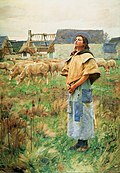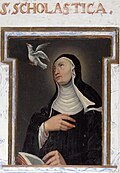List of 999 women of the Heritage Floor / Brigida von Kildare
This list describes the place setting for Brigida von Kildare on the table of Judy Chicago's art installation The Dinner Party . It is part of the list of 999 women on the Heritage Floor who are assigned to the respective place settings on the table. The names of the 999 women are on the tiles of the Heritage Floor, which is arranged below the table and belongs to the art installation.
description
The installation consists of a three-sided table, each with 13 historical or mythological personalities, thus a total of 39 people, from prehistory to the women's rights movement . These people were assigned a place setting at the table, consisting of an individually designed table runner, an individually designed plate, a goblet, knife, fork, spoon and serviette. The first page of the table is devoted to prehistory up to the Roman Empire , the second to Christianization up to the Reformation and the third from the American Revolution to the women's movement. Each place setting on the table is assigned additional personalities who have received an entry on the tiles of the Heritage Floor, which occupies the space under the table and the center of the space between the sides of the table. This list includes the personalities assigned to Brigida von Kildare's place setting. Your seat is on the second side of the table.
Hints
In addition to the names as they are used in German transcription or in scientific usage, the list shows the spelling chosen by Judy Chicago on the tiles.
The information on women who do not yet have an article in the German-language Wikipedia is referenced by the individual references listed under comments . If individual information in the table is not referenced via the main article, additional individual references are given at the relevant point. If there are any discrepancies between the information provided in Wikipedia articles and the descriptions of the work of art on the Brooklyn Museum website , this will also be indicated under Comments.
Place setting for Brigida von Kildare
Brigida von Kildare was born around 451 in Faughart near Dundalk as the daughter of King Dubhthach von Leinster and Brocca, a Christian Pictin . Her mother wasbaptizedby Patrick of Ireland . With her generosity and willingness to help the poor and sick, Brigida is said to have angered her father and entered a monastery. The double monastery of Kildare , which also led to the founding of the town of Kildare, was founded by her in 470. She died on February 1, 523 in Kildare. February 1st has been named her feast day and Brigida has been named Irish Saint.
Although early accounts of Brigida are legendary, most historians consider her a historical figure. Some, however, suspect that the Celtic goddess Brigid was transformed into a Christian saint behind her .
Brigida is depicted as a flame on the plate of her place setting. This flame also surrounds the Celtic cross on the back of the table runner, as does the initial "S" on the front. In an early drawing for the place setting, Chicago referred to her as the "goddess of milk and fire". The flame stands for the literal translation of its Celtic name, which means "fiery arrow". On the plate, the flame is shown in an abstract form, in the center with blue and orange tongues that merge into green-yellow shapes on the outside. In the lower area there are tongues in a strong orange, which at the same time gives the impression of a flower, which is not attacked by the flames. The superimposition of the images should suggest that the Christian saint Brigida arose from the pagan and Celtic goddess Brigid.
The front of the table runner has a border with a wooden panel, which is designed with a Celtic knot motif . On the back is a stylized Christian wooden cross based on a Muiredach cross , a symbol of Irish Christianity. The wooden elements are made of oak. The oak is said to remind of the first Kildare monastery founded by Brigida or "the church of the oak".
| Surname | Spelling on the tile | Date of birth | cultural spatial assignment | Remarks | image |
|---|---|---|---|---|---|
| Basena of Thuringia | Basine | before 466 | Late antiquity , Franconian Empire | As the wife of the Merovingian King Childerich I, Queen of the Franks . |

|
| Brigh Brigaid | Brigh Brigaid | 50 | Old Ireland | Official as Brithem in Ireland, is mentioned in the Senchus Mór . | |
| Cambra | Cambra | N / A | Britain | In British legend, Cambra was the daughter of Belinus the Great, a legendary king of the British, and married to Antenor, the second king of the Cimmerians. The Cimmerians changed the name of their tribe to Sugambrer in honor of Cambra. Cambra's son of Antenor, Priam the Younger, succeeded his father when he was 26 years old. | |
| Eugenia of Rome | Eugenia | at 180 | Roman Imperial Era | Martyr. She is venerated as a saint in the Catholic and Orthodox Churches . Her Greek name means "noble born". |

|
| Genoveva of Paris | Genevieve | at 422 | Late antiquity , Paris | Consecrated Virgin and Saints . She is the patron saint of Paris. |

|
| Lucia of Syracuse | Lucy | 283 | Late antiquity | Early Christian consecrated virgin and martyr . |

|
| Martia Proba | Martia Proba | 4th century BC Ch. | Britain | According to legend, queen of the island celts . | |
| Maximilla | Maximilla | 2nd century | Roman Imperial Era | One of the founders and prophets of Montanism , an early Christian movement. | |
| Scholastica of Nursia | Scholastica | at 480 | Late antiquity | Consecrated virgin and sister of St. Benedict of Nursia . She is considered the first Benedictine woman. |

|
| Sylvia of Aquitaine | Sylvia | 4th century | Late antiquity , Aquitaine | Pilgrim from Aquitaine . She was the sister of Rufinus , Prime Minister of the Eastern Empire under Theodosius and Arcadius . | |
| Thecla of Iconium | Thecla | 2nd century | Roman Imperial Era , Iconium | Elegant virgin from Iconium who, according to the Acts of Paul , was a pupil of the Apostle Paul . |

|
- Individual evidence
- ↑ Brooklyn Museum: Saint Bridget. In: brooklynmuseum.org. Retrieved October 19, 2019 .
- ↑ Brooklyn Museum: Brigh Brigaid. In: brooklynmuseum.org. Retrieved October 19, 2019 .
- ^ John Lewis, The history of Great-Britain: from the first inhabitants thereof, 'till the death of Cadwalader, last king of the Britains . Printed for F. Gyles, Mess. Woodman and Lyon, and C. Davis, London, 1729
- ^ Brooklyn Museum: Martia Proba. In: brooklynmuseum.org. Retrieved October 19, 2019 .
- ↑ Brooklyn Museum: Maximilla. In: brooklynmuseum.org. Retrieved October 19, 2019 .
- ^ Brooklyn Museum: Sylvia. In: brooklynmuseum.org. Retrieved October 19, 2019 .
Web links
- Brooklyn Museum, Brigida of Kildare
- The Dinner Party on the website of Through the Flower , Judy Chicago's non-profit organization
